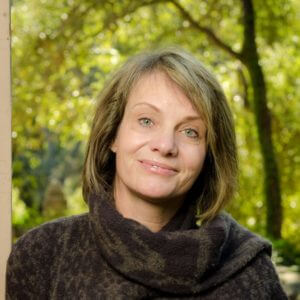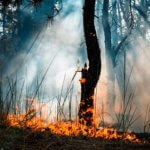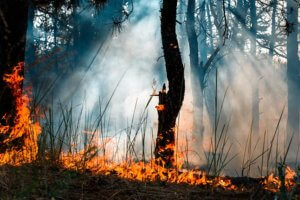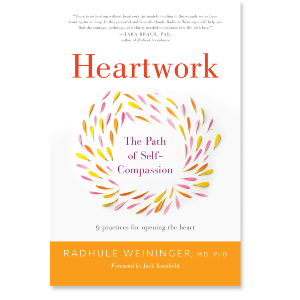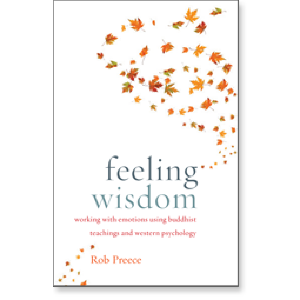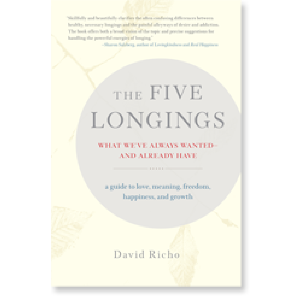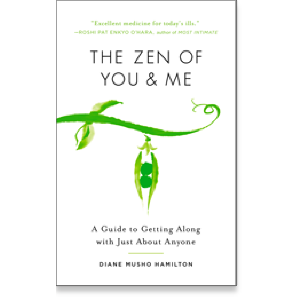by Radhule Weininger, author of Heartwork
“If the world is to be healed through human effort, I am convinced it will be by ordinary people, people whose love for life is even greater than their fear. People who can open to the web that called us into being.”—Joanna Macy
The Flames of the California Fires
From the top of our roofs we could see the fires crawling over the hills closer and closer towards us. In December 2017, Santa Barbara was stricken by the most significant fires on the West Coast of America. For about two weeks, our little town felt like a post-apocalyptic landscape, deserted, with shops closed and scattered people wearing facemasks and shawls, scurrying through the deserted streets. Thrown back and forth between terror of annihilation and detached numbness, many of us hunkered down at home glued to the TV screens or fled town.
The Santa Barbara fire followed closely on the heels of catastrophic burns in California and hurricanes in other parts of the country as well as environmental distress spreading throughout the world, from Puerto Rico and Mexico to Bangladesh. Our fire flared against the backdrop of a harrowing year in the political and social arena. Environmental protections had been stripped away as well as healthcare, respectful treatment of immigrants, quality education, and human rights.
In the midst of the desolation of the fire crisis, when many of us felt contracted, lonely, and shrunken, the yellow-clad bodhisattvas had rolled in on their red chariots. Youthful, strong firemen and women faced the inferno on all of our behalf. Their willingness to give, to risk it all for our townspeople, saved not only countless lives and houses but also momentarily restored trust in the goodness and generosity of life. One of the bodhisattvas, a 31-year-old man, father of a young girl, tragically lost his life in the fire. His willingness to give up everything to save others softened our hearts.
Another Catastrophe
Who would have dreamt that three weeks later, as we were beginning to heal from the fire, rains would come to devastate the fire zone with a mudslide? No one was prepared for this catastrophe. After the fire and before the flood there was a strangely surreal hiatus between tragedies. For a few days we were inspired by the compassion and courage of others, and we tried to believe that all was normal again. It was surprising how we seemed to rebound when the flames had receded just days before the holidays. We took on Christmas with gusto; we shopped away and cooked up a storm while trying to forget the recent calamity. Yet, a strange sense of hollowness and unreality remained. I found within myself a nagging sense of unease. Caring only for ourselves and our near and dear ones did not seem enough.
Yet, a strange sense of hollowness and unreality remained. I found within myself a nagging sense of unease. Caring only for ourselves and our near and dear ones did not seem enough.
Right after New Year’s, when the rains descended, the mountain moved, and immense masses of rocks and mud slid down to decimate our town. A gargantuan rain and mudslide left a significant area destroyed, hundreds of houses demolished or damaged, and over twenty people dead. Several victims have still not been found. Overwhelmed with emotions, many of us wondered if we were experiencing a preview of a nightmare future. We experienced ourselves as vulnerable, little creatures, easy to hurt, if not extinguish. We felt the vulnerability of our broader world. While the immense rocks tumbled down the mountains, our hearts cracked wide open. With so many human lives lost, our community was devastated, and because so many were displaced, those of us remaining were brought together by our tears.
The Stories
We were broken open to one another by amazing stories of human bravery and generosity. Curtis, a local man, stayed behind intentionally, so he and his neighbor could help all the other people on his street get out of their houses and into safety. Connor, a twenty-two-year-old friend of my kids from school, tried in vain to pull his dad out of the stream of mud. A young firefighter risked his own life to dislodge a family of five and their dog from their destroyed house: to lift them, one by one, into a helicopter. The family, who had lost their father, received generous donations from a GoFundMe collection; they gave the whole sum to an underprivileged immigrant family, a father and his two-year-old son, who had lost their mom and siblings in the stream of sludge and boulders. Hearing about these and many other examples of selfless and compassionate action freed us from isolation, and, for a brief time, allowed us to know the web that called us into being to remember that we “inter-are.”
As much as I wished that this catastrophe had never happened, at the same time I appreciated what we were learning. I began to worry that our open hearts would close up again. I recognized that the events here were a microcosm of what is happening on a global level. We had been catapulted into what may well be our future, a future foreshadowed by what is already happening in many other parts of our world. As humans we are pulled between closing up and self-protection on the one hand and openness towards others and generosity on the other. This is a fundamental dynamic for all of us as we face difficult times.
As much as I wished that this catastrophe had never happened, at the same time I appreciated what we were learning. I began to worry that our open hearts would close up again. I recognized that the events here were a microcosm of what is happening on a global level. We had been catapulted into what may well be our future, a future foreshadowed by what is already happening in many other parts of our world. As humans we are pulled between closing up and self-protection on the one hand and openness towards others and generosity on the other. This is a fundamental dynamic for all of us as we face difficult times.
In his best seller, Why Buddhism is True, developmental biologist Robert Wright argues that over the millennia it may have been to our evolutionary advantage to be greedy, selfish, and “delusional” in our perception of ourselves and reality. Boosting up our egos and grasping whatever we could for ourselves may have advanced our family’s or tribe’s position. Now this kind of behavior is threatening the survival of our ecosystem, and it brings the gravest suffering to many parts of our world. Wright has a recommendation for us: as genetic evolution is too slow to save us now, we need to engage in cultural evolution; meaning, we need to cultivate attitudes that help our societies to transform and our planet to survive and heal.
The Buddha’s Idea of Dependent Co-Arising
As I contemplate that which might support us in holding our experience in a more caring and respectful way, I think of a phrase I heard recently from Joanna Macy: “mutual belonging.” She used this term in her explanation of the ancient Buddhist idea of dependent co-arising. The Buddha saw life as continuously emerging and then falling back into the stream of becoming. He showed us how everything co-arises in interaction. The reality we experience ascends from what we bring to it, our intention, effort, mood, and awareness. Life is changing as we participate in it. Training in understanding of dependent co-arising helps us to cultivate attitudes of caring towards a widening circle of others. As our caring widens, our perceptions and behaviors change, allowing us to develop more compassionate ways of being with each other and our world.
The Buddha taught that we suffer deeply when we stay imprisoned in a “delusion of separateness.” As we remain stuck in fear and alienation and as we cling to what by nature is transient, we become more and more entrapped. I see this with some of my psychotherapy clients. Those who have been so frightened by life that they have retreated into a shell of self-protection find themselves cut off from the stream of life. They often suffer the secondary trauma of isolation, quiet and desolate anxiety, and loneliness. By contrast, I have seen that it is possible to free ourselves by living our true nature, that of inter-being, joining the dynamic of life itself. Awareness of our interconnectedness as well as the fact that we all affect each other in everything we do can then become the basis for a dynamic bridge-making between ethics and metaphysics. If we cultivate attitudes of being that help us abstain from violence, greed, and self-preoccupation and instead practice awareness, kindness, and caring for all life, then our own suffering and that of others will spontaneously decrease.
Practically speaking, how can we engage in Wright’s cultural evolution? How can we here in Santa Barbara remember Joanna Macy’s call to practice our radical interconnectedness with all of life? How can we cultivate attitudes that help our societies transform and our planet to survive and heal?
Practically speaking, how can we engage in Wright’s cultural evolution? How can we here in Santa Barbara remember Joanna Macy’s call to practice our radical interconnectedness with all of life? How can we cultivate attitudes that help our societies transform and our planet to survive and heal?
The “Solidarity and Compassion Project”
A little over a year ago, in response to feeling overwhelmed and despondent in the wake of the presidential election, my husband, physician and author Michael Kearney and I initiated monthly community meetings called the “Solidarity and Compassion Project.” In each meeting, we addressed a different theme and invited a panel of speakers, representing a range of spiritual, intellectual, scientific, and psychological perspectives to join us for practice and discussion. Poets and musicians also joined us as we learned that joy is the much-needed antidote to despair and grief. Each meeting combined meditation with an exploration of sustainable ways to bring compassion and engagement to the many social, political, and environmental challenges we are confronting.
Serendipitously, in December, before the fire and mud, we had planned that the theme of our January gathering would be about grief. Meeting in the belly of an old church with richly colored windows allowed us to exhale after we had held our tension in so tightly during the weeks of fire, downpours, and rolling mountains of sludge. Guided meditations allowed us to be present with our inner feelings of rawness, dread, and alarm, as well as continuous feelings of uncertainty. Michael and I led participants in loving awareness and mindfulness practices with phrases, such as “Let yourself settle into the sensations in your body, and notice whether there is tightness, ache, or vibration. Feel breath arising with the inhale, letting go with the exhale, allowing the warm breath of life to breathe you.”
We also led the group in compassion practice, inviting all to extend caring to themselves and others in a gentle and relevant way. I suggested that those gathered quietly repeat the phrases I offered. I said, “May I treat myself with gentleness and understanding in this time of loss. May I meet my grief with tenderness and care,” and, “May I be compassionate and patient with myself, especially when I feel afraid.” Widening the circle to include others in our care, I continued, “May those close to us be healthy and protected. May all those who were hurt in this crisis be safe well again,” and, “May those in this world who experienced similar traumas to ours find the support they need to heal.”
Finally, we began to relax. Together we were able to feel the feelings of last week’s experiences. Images arose of burning mountains and memories of the alarming voices of TV announcers shouting their warnings. We remembered the dark grey air, the torn apart houses, the mud-covered areas that had once been streets; we remembered the faces of those dead or missing. Within the safety of community and practice, we were also able to feel the sensations of our stressed nerves, so raw and fried. Feelings, thoughts, and image debris were released within the safety created by this practice of mindfulness meditation—all passing down a river of loving awareness.
When we feel afraid, lost, and trapped within ourselves, practicing self-compassion can reaffirm our willingness to extend a hand towards our own traumatized inner selves. As we gradually make friends with ourselves, compassion for others will follow more easily.
When we feel afraid, lost, and trapped within ourselves, practicing self-compassion can reaffirm our willingness to extend a hand towards our own traumatized inner selves. As we gradually make friends with ourselves, compassion for others will follow more easily. We extended warmth and understanding towards that in ourselves which was afraid and lost; we thawed out the cold spaces within and around our hearts. It felt as if the cores of our beings had contracted in the midst of so much agitation and panic. Like shy birds with their heads pulled in, we needed breath to breathe us into calm, warmth, and tenderness. Then, we sat together for a long time, sharing what we’d been through, remembering Curtis, Conner, and the young fireman. Through love and developing equanimity, we began to learn to tolerate the rawness of our experiences. My husband Michael puts it like this: “The more connected we are, the more we care. The more we care, the more we long to do what we can to improve the well-being of others. And in that process, we heal.”
In recent weeks, groups of volunteers of all ages and of all parts of the community, the “bucket brigades,” emerged. These groups of community volunteers have gathered every weekend and moved “bucket by bucket,” restoring damaged homes and landscapes. One young woman, Anahita, who lost a close friend in the mudslide, shared in one of our gatherings, “At first I felt more triggered than anticipated by seeing all the mud and debris. It reminded me of our friend who died, and I felt like I had more of a tangible visual and tactile feel for how she lost her life. But as I connected to the people and the mission of the bucket brigade, and as we picked up our shawls and started slowly chipping away, I felt a sense of healing in this. Tears welled up in my eyes—tears not only of grief but also of gratitude, for community healing in action.”
Dealing with Catastrophe
Catastrophic events challenge us to find new ways to reintegrate our psyches. I am grappling with unanswered questions: What do we learn from such events? Do we go back to “business as usual,” trying to forget as fast as we can? As research on groups of people threatened with annihilation suggests, will we close up, become more rigid, look for scapegoats, and turn our grief into blame? Or can our hearts stay open and soft with increased compassion for others who suffer through similar plights?
A few weeks after our first gathering, I led a meditation in Montecito, in the area that had been most devastated by the mudslide. Huddled together in a yurt-like structure behind a store, in what is called the “Sacred Space,” fifty people came to meditate together, listen to stories of loss and trauma, of uncertainty, fear, and hope. A man told us about the anxiety that still wakes him up every morning at 3 a.m. A woman talked about how she found gratitude for what is truly essential in her life after her house had been completely flushed away. There was a raw and open feeling in the room.
Recently, I heard that there are lawsuits looming in Santa Barbara, some devastated residents blaming others as culprits for nature’s disaster. What is happening in our little town is mirrored by the developments in our country where we face daily choices between angry blame and proactive compassion. Experiencing the mudslide brought out a whole spectrum of responses. Some have found themselves retreating into understandable behaviors of self-protection, while others have turned towards initiatives leading them to reach out in generosity. A grocery store and several restaurants at the edge of the disaster zone opened their doors to give free water and meals to survivors and first responders.
How do we turn adversity into an opportunity to grow and love and heal? Holding this question, I was reminded of the well-known American Indian story “Which Wolf do we Feed?” This is the version told by Algonquin elder Wolf Wahpepah:
You probably heard the story of the Indian boy who went to his grandfather for wisdom. His grandfather told him, “Inside of me there are two wolves, a selfish wolf and a compassionate wolf. And they fight all the time. The selfish wolf tells me to look out for myself, to feed my appetite. The compassionate wolf says I should be concerned about the welfare of all and be concerned about their needs.” The grandson asked his grandfather, “Well grandfather, which one of the wolves wins?” Grandfather replied, “Whichever one we feed.”
This article is about practice, choice, and cultivating an attitude of compassion and caring. We need to develop structures that are based on an understanding of interdependence and inter-being, that recognize our mutual belonging and radical interconnectivity. Gradually, as we align ourselves one by one with these structures of mutual belonging, we create a culture of compassion and spontaneous caring.
What has happened in this tiny microcosm of Santa Barbara might have significance in a much broader context. As we get thrown about by increasingly intense environmental events, as resources for many are getting slimmer, and as our weapons of mass destruction become increasingly ominous, we in our broader world need to cultivate what we are learning in Santa Barbara. We need to teach ourselves to be generous, open-hearted, and inclusive.
Related Books
$16.95 - Paperback
$21.95 - Paperback
$21.95 - Paperback
$12.95 - Paperback
